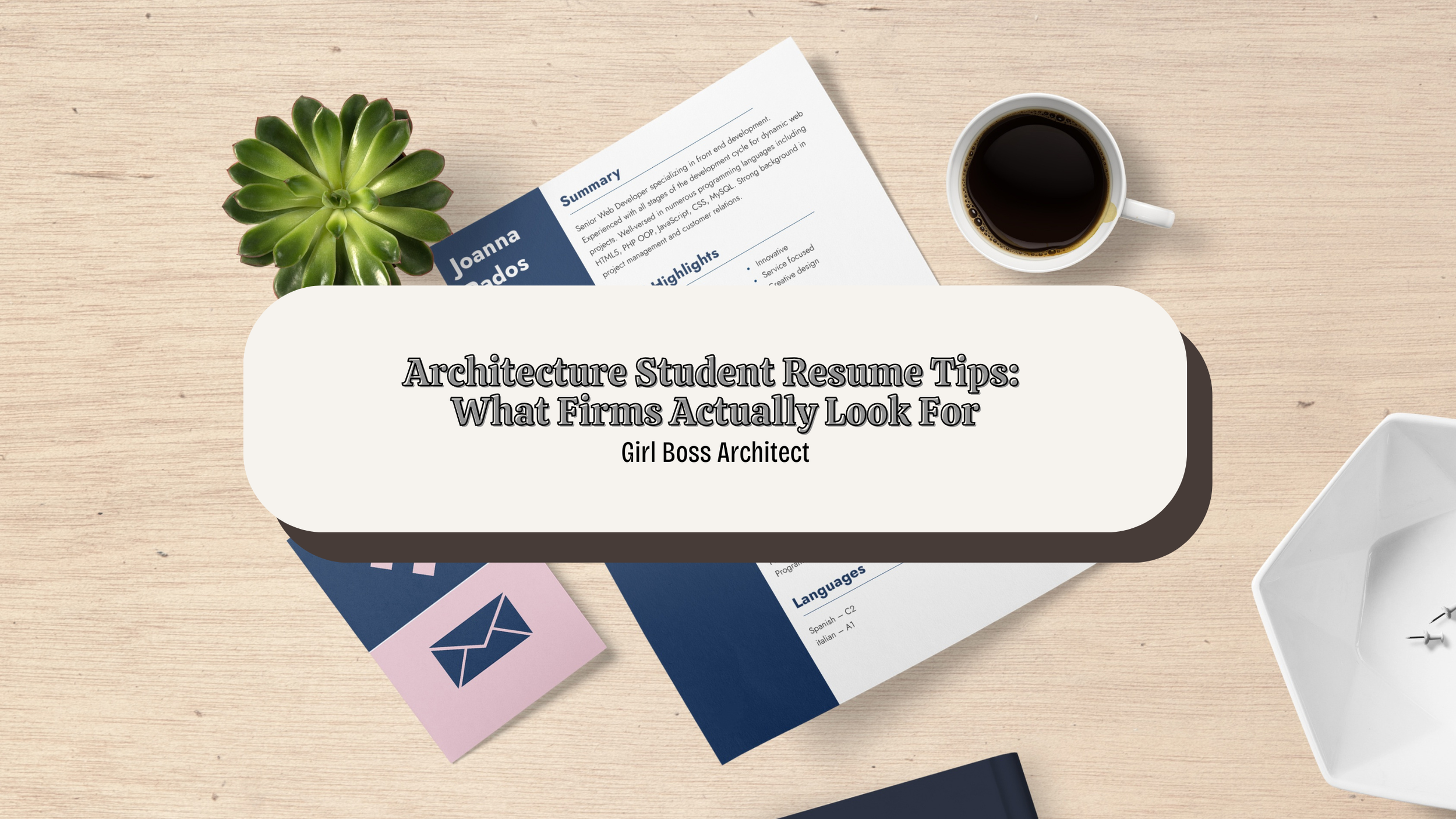Architecture Student Resume Tips: What Firms Actually Look For
Putting together an architecture student resume can feel intimidating. You're trying to sum up years of design work, long studio nights, and a hundred iterations of a single project (which you shouldn’t do). On top of that, it has to look professional, creative and not like everyone else’s work. It feels like resumes are its own design plate.
But the truth is, your resume isn’t a summary of all your experience. It’s a document that communicates who you are, how you think, your growth through the years, and what you bring to the table. It’s supposed to contain your most significant experiences.
In this guide, let’s break down what architecture firms are really looking for in a student or entry-level resume, and how you can craft one to catch their attention (in a good way).
Most Important Elements in Your Architecture Student Resume
1. Clear-Cut Elevator Pitch
If you’ve checked out resume examples online, you might have noticed a section called “Profile Summary.” Think of this as your “elevator pitch section.” It’s a high-level summary of your credentials, character, values and accomplishments.
Just as how your beautifully designed buildings come with a clear concept, your resume requires the same. And your profile summary is that introduction that will make everything else in the resume make sense.
2. Strong Soft and Hard Skills
Most firms don’t expect you to have years of polished experience fresh out of architecture school. Instead, they’re looking for:
Strong problem solving skills through design
Software fluency
Attention to detail
Good communication skills
A growth mindset
They want someone who can jump into a team, contribute meaningfully, and grow with the studio. Whether it’s for an internship or your first full-time gig, your resume should say: “I’m ready to learn, I work hard, and I bring something valuable.”
You should also tailor your resume based on the firm you’re applying to. For instance, if a corporate firm cares more about BIM skills, then highlight that on your resume. Smaller studios may add more value toward conceptual thinking and hand-drawing, so it helps to know your audience.
When writing about your skills, you can break the section down into categories. For instance, list your technical skills first like Revit, Rhino and Lumion. Then write your fabrication skills like laser cutting and 3D printing. After which, include your soft skills like collaboration and time management.
3. Well-Organized Resume Structure
The best resumes are limited to one page only. It shouldn’t include your whole academic life story, and brevity shows clarity. Here are the other sections to include:
Contact info: Your contact information is best close to your full name. Include your phone number, professional email, LinkedIn profile and portfolio link. If you don’t have a professional email yet, best to create one right away!
Education: This section includes your degree, school, graduation date and other notable courses or thesis.
Experience: This part can include your internships, freelance work, research assistant experiences or studio projects you’ve worked on.
Awards and honors: List your scholarships, dean’s list and design competition awards.
Certifications: If you have them, list them — Autodesk certifications, LEED Green Associate, etc.
A clean, grid-based layout is ideal. Though as a designer, you’d know best how to organize your info. Make sure you don’t go overboard with the graphics and save the creativity for your architecture portfolio.
What to Highlight in Your Resume
Some architecture students undervalue what they’ve done. You don’t need to have worked at the big companies or projects to impress. You just need to frame your experience effectively.
Studio Projects
Pick 2–3 significant ones and describe your role. For instance, did you:
Lead the concept phase?
Coordinate with other students?
Use real-world constraints (budget, climate, client input)?
Your portfolio should do the deep dive into these projects, so best to keep things concise in your resume. You can also mention for readers to check out your portfolio for the visuals.
Technical & Soft Skills
In every project you include, don’t just list software — give context. For instance, instead of listing “Rhino, Grasshopper, V-Ray,” try saying “Used V-Ray to produce high-resolution renderings for final reviews.”
You can also add results to highlight your impact on the project. For instance, you can say “Collaborated with the team effectively during tight deadlines, avoiding delays and miscommunications.”
Use the formula: Action verb + context + result (if possible)
Use powerful verbs for impact. Every bullet should answer, “What did I do?” and “Why did it matter?”
If you took initiative, like organizing an exhibition, mentoring underclassmen, learning new tools outside of class—that’s gold. Don’t be shy about it.
Common Resume Mistakes to Avoid
Let’s clean up some common traps architecture students fall into:
Being too vague: Specificity is key. Instead of saying you “worked on a design project in studio,” try saying “designed a net-zero energy library for a rural site in [location], focused on passive cooling.”
Over-designing the resume: Subtle formatting, without the giant infographics, color blocks or Comic Sans is better. Stick to one or two clean fonts (Sans serif recommended). Choose up to one accent color only.
Using one resume for all applications: Each firm is different. Customize your resume just like you’d tailor a cover letter or portfolio.
Not linking their portfolio: Make it super easy to find your work. Include a clickable link to your digital portfolio and make sure it works (especially on mobile).
Most recruiters and firm principals are busy. They’ll scan your resume in under 10 seconds before they decide whether to dive deeper. Strong and specific bullet points, a clear layout and easy-to-find portfolio will work in your favor.
Also, make sure your file type is in PDF, unless stated by the company otherwise.
Customizing Your Resume for Each Firm
Creating your resume is like designing for a client. You need to be specific for each one. Research about the firm and identify what kind of work they do, what tools they work with and what language they use in job postings.
Mirror these in your resume, provided they’re all truthful. For instance, if a firm values sustainability, highlight your green building coursework or your thesis on passive systems.
If you’re trying to land work abroad, you can emphasize your universal skills, like design thinking, BIM software and research. Clarify the location and constraints of the projects you talked about, in case they’re unfamiliar to your readers.
Tools, Templates and Resources
To design your resume more easily, consider these tools:
Canva: Easy-to-use and free (tons of resume templates)
Adobe InDesign: Best for custom formatting (especially if you already use the software)
Portfolio Sites: Wix and Squarespace can host your online portfolio
Final Thoughts: Your Resume Is a Design Problem
At the end of the day, your architecture resume isn’t just paperwork. It’s a chance to tell your story, frame your work, and show that you’re thoughtful about how you present ideas.
So treat it like a design challenge:
Understand your “client” (the firm)
Research the “site” (job requirements)
Make something functional, clear, and beautiful
Start small. Just one section. You don’t need to perfect it right away. But the key is to get started.



